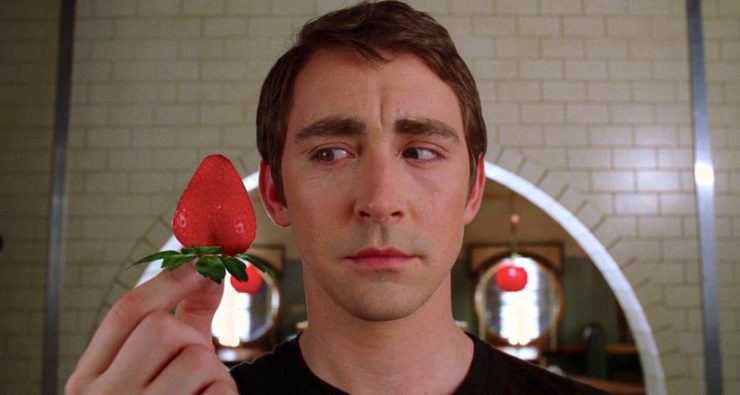As of this writing, it’s been 15 years, 17 days, and 21 hours since Pushing Daisies premiered on ABC. The show was part romantic comedy, part murder mystery, and part musical, all liberally sprinkled with a heaping spoonful of sugar, spice, and everything nice.
The story centers on an anxiety-riddled baker named Ned who makes pies and wakes the dead. In childhood, he watched as a truck hit his golden retriever and discovered that he possesses a very odd, special power: Ned can bring corpses back to life with a single touch. His next brush with death happens soon after, as his pie-baking mother dies suddenly when a blood vessel bursts in her brain. Though young Ned revives her with his magic touch, he’s horrified to learn that if he lets the dead live for more than a minute, another living thing in close proximity will perish. The cost of resurrecting his mother is the death of his neighbor—the father of his childhood sweetheart, Charlotte “Chuck” Charles.
But Ned faces another unfortunate revelation: when his mother kisses him goodnight, she dies again, this time forever. While a single touch brings the dead back to life, a second touch from Ned will send the recently revived immediately back to the great beyond. (Side note: Pushing Daisies and this brand of fantastical-element-in-a-contemporary-setting partially inspired my recent piece about curio fiction.)
The trauma of such a childhood is enough to make anyone sequester themselves in a pie shop and avoid close relationships. However, Ned finds himself roped into a side hustle when a private investigator named Emerson Cod glimpses his powers and enlists his help in solving murders. Together, they make regular use of the morgue, where Ned can directly ask victims how they died and who killed them.
From the first episode, “Pie-lette,” viewers are thrust directly into the show’s beating heart with the irresistible romance that drives Pushing Daisies—the impossible love story between Ned (Lee Pace) and Chuck (Anna Friel), whom he revives from her casket in a fateful reunion after many years apart…then can’t bring himself to “re-dead” her. Of course, the nature of Ned’s power means the two lovers can never touch again, lest Chuck be sent to her grave permanently.
Pushing Daisies only ran for two seasons, with a grand total of twenty-two episodes aired from 2007 to 2009. Despite the show being nominated for seventeen Emmy Awards and winning seven, it was ultimately canceled by ABC. The Writers Guild of America strike during those years may have contributed to the show’s short run, along with an exorbitant per-episode expense and low season two ratings. Regardless of the reason for its cancellation, Pushing Daisies managed to establish a loyal fandom and frequently appears on reboot wish lists, memorializing it in the mausoleum of shows that were taken from us far too soon.
Show creator Bryan Fuller’s previous projects, Dead Like Me and Wonderfalls, were equally quirky and also had short runs. Fuller later went on to develop American Gods, Hannibal, and Star Trek: Discovery. His signature style focuses on striking visuals, larger-than-life characters, and death-related themes, all of which are prominent features of Pushing Daisies.
So: How did this show manage to leave such a lasting impression on viewers—especially yours truly—despite it being canceled after two seasons? The facts are these…
The Sugary Vibe
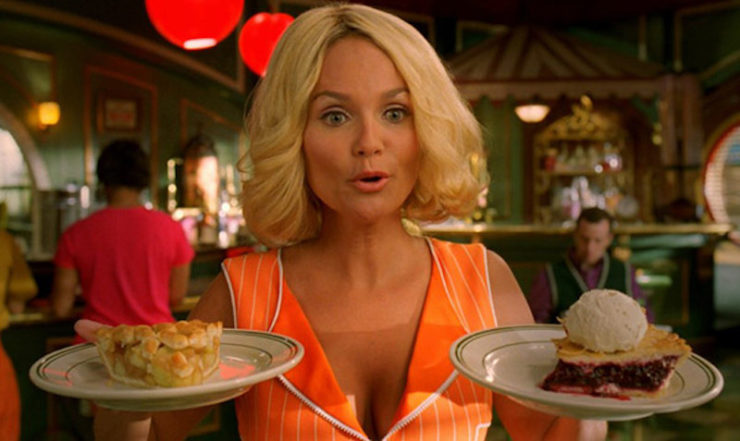
“This is not strange—unusual, maybe. Eccentric, in a quaint way, like dessert spoons.” –Ned, Season 1, Episode 2
The show’s warm, pop-art aesthetic is instantly recognizable. From the endless fields of yellow daisies in the town of Coeur d’Coeurs to pastel-colored sets filled with pies, candies, and (occasionally) circus performers, the visuals go big on spectacle and create a feast for the eyes. Like the movie adaptation of the novel Big Fish, Pushing Daisies embraces a whimsical tone and fanciful characterization that fosters the feeling of a myth or fable.
The fact that the series isn’t wedded to realism means that every detail can be unabashedly over the top. That includes cheekily green-screened effects, including a spoof on Hitchcock’s The Birds folded into an antagonist’s traumatic backstory. The characters often wear eye-popping outfits, particularly the female leads, Chuck and Olive, who don vintage-style dresses and skirts in bright yellows, reds, blues, and greens that would make a bubblegum machine envious. Alliterative or repetitive names like Charlotte Charles (“Chuck”) and the Darling Mermaid Darlings give the story a Dr. Seuss-like cadence. Occasionally, Olive Snook—played by Broadway star Kristin Chenoweth—will break out into song in scenes that exist solely to showcase Chenoweth’s vocal chops. In any given episode, you can expect a quaint-yet-distinct setting, whether it’s a nunnery or a honey-based cosmetics company.
Then there’s the voiceover from Jim Dale, the same actor/singer/vocal artist extraordinaire who narrated the audiobooks about a certain boy wizard. His matter-of-fact editorializing lends the story both gravitas and tongue-in-cheek humor: “Olive Snook had been delivering pies for weeks,” the omniscient narrator drawls, “not realizing she was a homeopathic drug mule.”
The juxtaposition of the bright, cheery color scheme and the murder-focused plots isn’t as jarring as one might think. Instead, the series offers all the trappings of a cozy mystery with a sweet aesthetic that risks bordering on twee, yet it focuses on serious questions of death, grief, love, and loss. Even the show’s title is an idiom of playful contrasts, with the lightheartedness of daisies paired with the darkness of death. It’s not hard to want to embrace that level of exuberant sentimentality in a world that’s too often full of cynicism and monochromatic gloom.
Above all else, the show’s iconic theme song makes my heart soar every time I hear it.
The Zesty Murders

“Musing on the idea of setting someone on fire doesn’t mean you REALLY want to set them on fire. It’s just the thought of it that makes you happy.” –Olive Snook, Season 1, Episode 3
There’s endless creativity showcased in the murder victims’ Willy Wonka-esque ends, including a body submerged in a vat of taffy and an incident involving an explosive scratch-and-sniff book. The almost cartoonishly exaggerated nature of the deaths in Pushing Daisies makes them all the more memorable. At the morgue, Ned revives corpses with tire marks on their faces, or covered in bee stings, or mostly frozen like Jack Torrance at the end of The Shining.
When Ned and his companions question the deceased, the victims are often blasé about their own deaths. They’re also comically honest, given they have nothing else left to lose, revealing more about their true selves in death than they would’ve in life. A nun blurts out streams of expletives; a beekeeper admits to corporate sabotage; paramours share their final confessions of love. These features contribute to Fuller’s vision of the show as a “forensic fairy tale,” wherein the police procedural meets the world of Hansel and Gretel.
While the murders can be gruesome, they’re also presented in a way that’s not disturbing or threatening, partly because of the deeply odd and improbable causes. It’s a surrealist world where mortality can be confronted from a safe vantage point, a curiosity to be peered at like a brain in a jar, while interactions between the living and the dead are leavened with touches of absurdity. The show’s dark humor can be curiously comforting in the way it embraces the strangeness of both life and death.
The Sweet Love
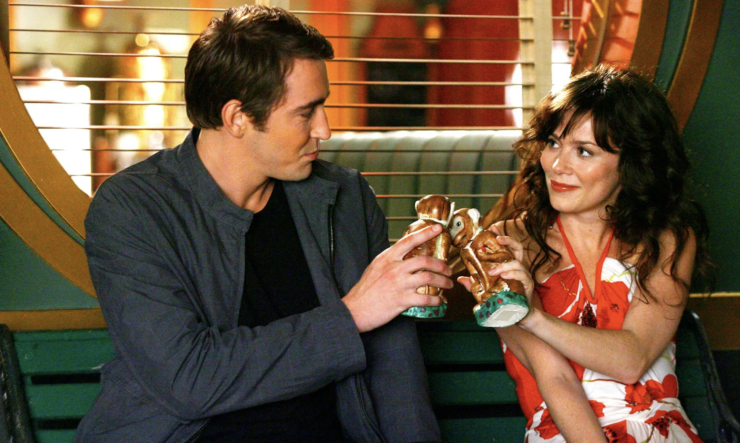
“As he stared at her, he reached around his back and held his own hand, pretending he was holding hers. And at that very moment, she was pretending to be holding his.” –The Narrator, Season 1, Episode 1
To me, there’s no greater example of star-crossed lovers than Ned and Chuck, who speak to the bleeding hearts of long-distance couples everywhere in the way that they can be so very close and yet can never touch. No matter how irrevocably they’re drawn together, they remain forever apart, except during risky saran-wrap kisses or beekeeping-suit dances. Despite the obstacles, they never fail to smile at each other from across the room or flirt by pretending to be new neighbors meeting for the first time.
They also inspire each other to grow, as in any good relationship. Chuck is bubbly and eager to offer a helping hand to everyone she meets, which challenges Ned’s introverted and fatalistic nature. With her relentless optimism, Chuck revitalizes his hopes for love and happiness. This is thanks in big part to Anna Friel and her delightful portrayal of the character, as she brought quirky, energetic wholesomeness and brunette bangs to the screen a few years before Zooey Deschanel in 500 Days of Summer and New Girl.
Ned gives Chuck continual kindness and support, even when it means letting her wander away from him. When Chuck expresses her desire for more independence, Ned is hurt at first, but then he surprises her by furnishing her new apartment with wall-to-wall books from her old home. She’s eager not to waste the second chance at life she’s been given, a mindset that speaks to my soul.
The love extends beyond Ned and Chuck’s romance to encompass the show’s core four characters, each role benefitting from truly wonderful casting that contributes to their delectable chemistry. In addition to the Pie Maker and the dead girl (as played by Pace and Friel), there’s business-minded private investigator Emerson Cod (Chi McBride) and former jockey/current waitress/future nun who’s smitten with the Pie Maker, Olive Snook (the aforementioned Kristin Chenoweth).
The four of them play off each other in predictable and unpredictable ways, their relationships evolving over time as they butt heads and forge bonds. Olive’s unrequited love for Ned is worthy of a rendition of “On My Own” from Les Misérables, yet Olive and Ned care for each other deeply, even if the romance is one-sided. Olive starts off as Chuck’s romantic rival, but the two women soon become genuine friends in a refreshing take on what might be a cliché love triangle in most other shows.
The dour Emerson is real tired of everyone’s shit, especially Dead Girl whenever she distracts his money-making corpse whisperer with her doe eyes. In almost any given scene, Chi McBride reliably carries the humor with his wry delivery of lines like, “Well, that idea might make a stupid idea feel better about itself.” The detective and the Pie Maker prove to be great foils in their buddy-cop dynamic; where Ned is awkward and boyishly shy, Emerson is confident and sharp-witted. The two solve case after case (accompanied by Lee Pace’s marvelous eyebrows, which deserve their own shout-out), facing near-death experiences at the hands of deranged murderers and living to tell about it. Emerson holds everyone at a distance, but he begins to open up emotionally—especially to Ned—as the show goes on. Even Emerson and Olive strike up reluctant collaborations, with Emerson helping her solve personal cases.
Chuck’s aunts, Lily and Vivian (played by the great Swoosie Kurtz and Ellen Greene, respectively), serve as an extended family to the core four. Chuck hides her resurrection from her aunts, since she assumes they’d die of shock if they knew their beloved niece was still alive after being murdered on a cruise ship. The former synchronized swimming duo have been shut-ins for years, so Chuck secretly sends them pies (with Gruyère baked into the crust, of course) made with homeopathic mood enhancers. As the one delivering the pies, Olive ends up befriending the reclusive aunts. Ned and Emerson visit them as well, with the aunts remembering Ned as the kindly neighbor boy.
These characters genuinely love and respect one another, even when they get on each other’s nerves, ensuring that every episode is jam-packed with genuine heart and humor.
The Spicy Secrets
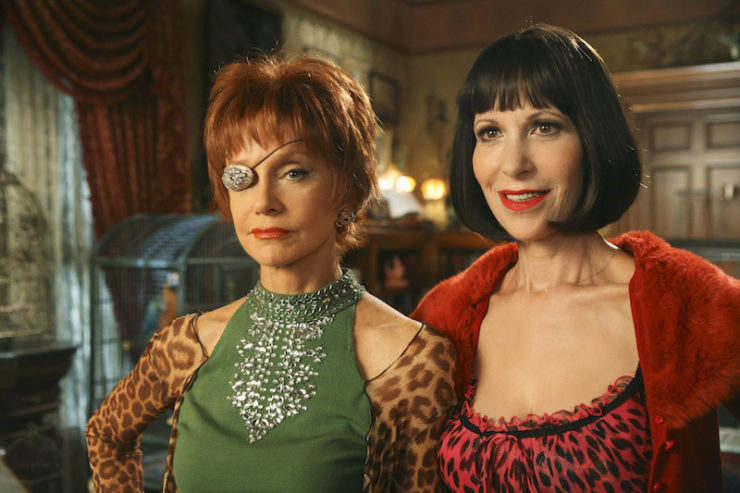
“I kind of killed her dad when I was ten.” –Ned, Season 1, Episode 1
Every episode also includes a spoonful of dramatic irony. When will nosy Olive discover Ned’s power to wake the dead and the fact that Chuck is one of his resurrection projects? How will Aunt Lily and Aunt Vivian react if they see their niece alive and well on their doorstep? And what about Ned’s biggest secret of all—that he inadvertently caused the death of Chuck’s father when he revived his mother?
All of these questions create emotional through lines amidst the cases of the week. Hidden family ties are also revealed across the course of the show, and Emerson Cod’s backstory introduces another mysterious thread to follow. These revelations were the moments I looked forward to most, anticipating reunions, heartbreak, and joyful celebrations.
If the show hadn’t been canceled, it’s doubtless that the creators would’ve introduced even more character backstories, woven through with new and intriguing complications. I suspect that Ned might’ve eventually encountered someone else with a power similar to his own—or even the reverse version, where a certain spoken word kills someone living. That person could’ve even been Ned’s estranged father, who would apparently have played a major role in the third season. (Fuller had promised to publish a comic book series to fill in more backstory and wrap up the narrative, but that never came to fruition.)
Another lingering uncertainty is how Ned and Chuck would manage to stay together as a couple incapable of physical contact, where one desires the safety of home and the other adventure in the great wide somewhere. Could Ned find a way to cure himself of his powers? Or perhaps there’s a loophole he hadn’t yet discovered? The answers to these questions and conundrums are known only to the show’s writers.
The Show’s Premature Death
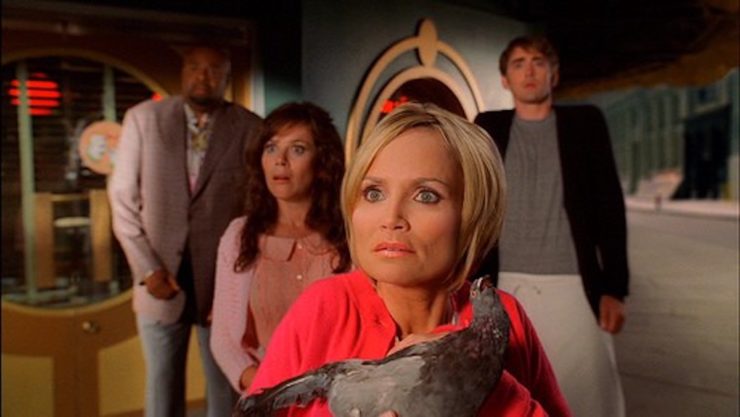
“I suppose dying’s as good an excuse as any to start living.” –Chuck, Season 1, Episode 1
For any show with a cult following, early cancellation evokes a reverence for what might’ve been (see also: Firefly, Heroes, Flashforward, etc.). A lack of closure leaves viewers imagining all the storytelling potential gone to waste. Those imagined possibilities probably exceed the level of emotional fulfillment of whatever ending the show would’ve had in reality.
I think this holds true for Pushing Daisies as well, where its longevity in the collective pop cultural consciousness—or at least, in my consciousness—is partially due to the show ending before its time. Too often, shows decline in quality as the seasons build. But when the story is left incomplete, it’s apotheosized to unconditional positive regard, without the disappointment of a lackluster finale or weird, dragged-out episodes that serve only to milk every advertising dollar. The show remains eternally underrated and thus adored as an eternal underdog.
With all the layers of praise I’ve been heaping on the show, it might seem like I’m about ready to start a cult that worships at the steps of The Pie Hole (which, in my humble-pie opinion, sounds like a promising episode of Pushing Daisies). For all its unique features, Pushing Daisies was by no means a perfect show, as it certainly had its fair share of experimentation run amok. The motivations for the murders are often forgettable, and interesting serial plot threads (like smell aficionado Oscar Vibenius discovering Chuck’s secret) were sometimes abandoned in the favor of the episodic police procedural. The dialogue occasionally loses its zing, and the main romance is occasionally left to on the back burner for several episodes at a time. Nevertheless, these flaws aren’t enough to detract from the overpowering and irresistible aroma of heartfelt, home-baked goodness that permeates the world of Pushing Daisies as a whole.
Pushing Daisies, Revived?
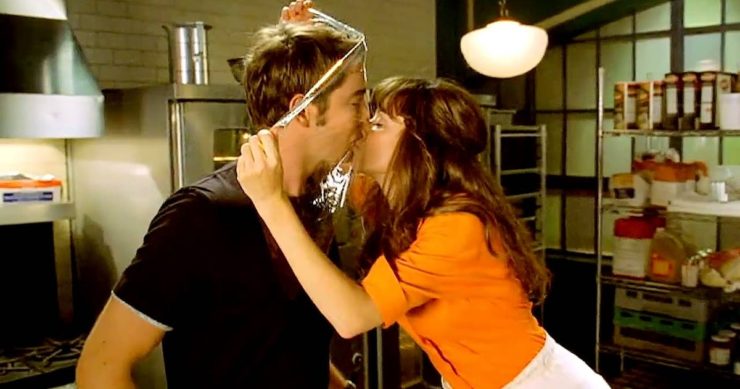
“At that moment, in the town of Coeur d’Coeurs, events occurred that are not, were not, and should never be considered an ending. For endings, as it is known, are where we begin.” —Narrator, Season 2, Episode 13
Many fans have hoped that the Pie Maker’s magic touch might somehow bring this special story back to life. It’s easy enough to find a show that can make you laugh, sigh, gasp in surprise, or temporarily lose faith in humanity with its insights into our darker natures. It’s much harder to find one that does all that at the same time, but also charms you to no end…
Recent shows like The Good Place and Ted Lasso have come closest to mirroring the tone of Pushing Daisies, but none have fully replicated its effervescent combination of fun, fresh, hopeful, fantastical, and darkly funny. Pushing Daisies is a show that warms the heart without ignoring the big questions in life. How do we face our inevitable mortality with humor and grace? How do we cope with loving at a distance or missing those who are gone from our lives?
Across the past decade, there have been occasional rumors and discussions about rebooting the show. Personally, I don’t want to see Pushing Daisies resurrected. Some dearly departed cultural artifacts are better left to their fate—truly gone but not forgotten—because they existed authentically as part of a particular zeitgeist. To unearth them now would feel like creating a counterfeit of the original’s spirit—fake and out of place. I would prefer that the show live on in the spirit of its time, its goodness forever captured in amber.
But, hey—I wouldn’t be opposed to a musical…
***
If you’re a fan of the show, let me know, and spread the love by sharing your favorite quote or episode from Pushing Daisies in the comments! I’ll even settle for your favorite type of pie. (Mine’s a tie between lemon meringue and banana cream.)
Note: At the moment, Pushing Daisies is available to stream on HBO Max, and available for purchase on other platforms.
Diane Callahan spends her days shaping stories as a writer and developmental editor. Her YouTube channel, Quotidian Writer, provides practical tips for aspiring authors.










